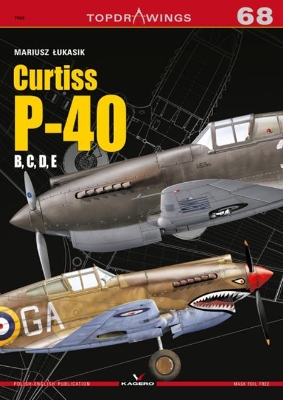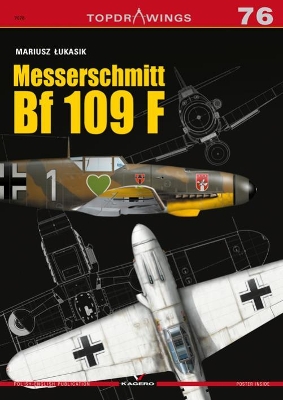TopDrawings
2 total works
The decision to start the production of the Curtiss P-40 fighter was made primarily due to the relatively low airframe price and the possibility of launching it almost immediately (based on Curtiss P-36s ready fuselages). The P-40 did not have a turbocharger, but despite this the requirements were constantly increasing, especially when it comes to the maximum speed. It was requested to raise it by over 100 km/h (up to 580 km/h). It required a number of construction changes e.g. new exhaust pipes, new shape and size of the air intake to the carburetor at the top of the engine cover, moving forward the coolers under the nose. After the tests in the NACA wind tunnel it turned out that these changes were not enough. The plane underwent further aerodynamic refinements, using, among others, smooth riveting and retractable tail ring. In the end, the speed was 589 km/h at 4570 m, which gave the green light for serial production.
Messerschmitt Bf 109 F (Friedrich) is one of the most important versions of this famous fighter. It was powered by the same engine (DB 601E) as the preceding Bf 109 E (Emil), but the airframe design differed significantly compared to its predecessor.
The plane gained a more aerodynamic profile due to the new engine cowling (the engine had its own starter, which resulted in the extension of the unit), a new, rounder propeller hub and rounded wing tips. In addition, supports were removed under horizontal stabilizers. Bf 109 F had its first flight on January 26, 1939.
Two prototypes were built. Two machines in version Bf 109 D were also rebuilt for testing the new engine installations. Friedrich had new under-wing radiators, which were twice as wide and lower than those used in the previous version of the aircraft. They were equipped with a two-part flap regulating the air supply. The prolonged tests and new requirements on the fighter’s armament delayed the implementation of Bf 109 F for series production.
The Messerschmitt company had signed a contract with the Reich Ministry of Aviation, which specified the requirements for two variants of the fighter’s weaponry: a light variant with MG151/15 in the fuselage and a heavy variant with MG FF/M in the fuselage.
The plane gained a more aerodynamic profile due to the new engine cowling (the engine had its own starter, which resulted in the extension of the unit), a new, rounder propeller hub and rounded wing tips. In addition, supports were removed under horizontal stabilizers. Bf 109 F had its first flight on January 26, 1939.
Two prototypes were built. Two machines in version Bf 109 D were also rebuilt for testing the new engine installations. Friedrich had new under-wing radiators, which were twice as wide and lower than those used in the previous version of the aircraft. They were equipped with a two-part flap regulating the air supply. The prolonged tests and new requirements on the fighter’s armament delayed the implementation of Bf 109 F for series production.
The Messerschmitt company had signed a contract with the Reich Ministry of Aviation, which specified the requirements for two variants of the fighter’s weaponry: a light variant with MG151/15 in the fuselage and a heavy variant with MG FF/M in the fuselage.

